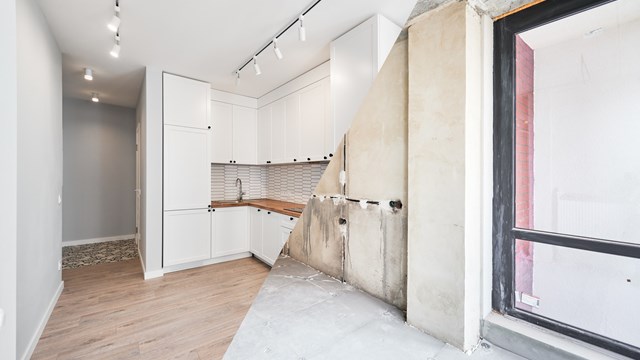The breakneck pace and cutthroat economics of residential real estate in New York City are legendary. For every new building that goes up, it seems like there's a battle to be fought, either with city agencies, community groups, preservation and historical societies, and anyone else with an opinion; which is to say, everyone else in the city.
But even with complicated zoning restrictions, spiraling development costs, and protracted bureaucratic wrangling, new development in the city continues at a rapid pace. The 2004-2005 development cycle has seen and will continue to see the city skyline punctuated with scaffolding of all descriptions and prices for both new and repurposed developments head north. Low interest rates, high prices for rentals, and the increasing desirability of nearly every neighborhood in New York City all seem to be contributing to the continuing real estate boom.
While new development happening all over the city thrills brokers eager for new properties to show their clients, a core problem remains: regardless of planned or new construction, the fact is that housing production continues to lag well behind demand, both in Manhattan and the outer boroughs.
According to Rachaele Raynoff, press secretary for the New York City Department of City Planning, "The increase in new residential construction is actually citywide. In 2004, we surpassed 25,000 residential permits. We see a steady upswing in new properties, and we see it as an enormous vote of confidence in the city after 9/11. It has not slacked off. People see New York as a great place to invest. People want to be here and they need to be housed."
They may want to live here, says Peter D. Salins, a senior fellow of the Manhattan Institute's Center for Civic Innovation, and a director of the Citizens Housing and Planning Council of New York, but as he writes in a recent report for the Institute titled New York City's Housing Gap: The Road to Recovery, they may find the housing part more and more difficult.
"During the period 1999"“2002, the housing gap grew by over 51,000 dwellings in Brooklyn; 36,200 in the Bronx; 22,400 in Queens; and 8,700 in Staten Island. Indeed," says Salins, "compared with its peers among American cities, New York's housing market is the least advantageous, with one of the oldest and most expensive housing stocks in the nation. There are a number of forces restraining New York's housing production, but among the most significant are its onerous land-use regulations and excessively high construction costs."
While city government officials and real estate developers continue to lock horns over how, where, and for what purpose new construction should take place, projects of all descriptions are springing up throughout the city - high construction costs and administrative red tape notwithstanding. Manhattan saw its share of new development this year along the length of the island, with many of the few remaining parcels of undeveloped or underdeveloped land suddenly surrounded by construction barriers heralding the next wave of residential building.
Nowhere was this more evident than in Lower Manhattan, where building incentives and tax breaks were available to developers looking to further reinvigorate the area surrounding the World Trade Center. By luring prospective residents with the appeal of both brand-new luxury housing as well as the conversion of a couple of historic buildings, developers - and the city itself - hope to draw more resident-oriented businesses, restaurants, nightlife, and shopping, turning the southernmost tip of Manhattan into a 24-hour neighborhood like its neighbors to the north.
Now that the sprawling fish market that once dominated the South Street Seaport has moved to the Bronx, the area surrounding the piers is a hotbed of residential activity. According to Sciame Development and Construction Co., 233 Front Street is an 11-story, 96-unit rental building comprised mostly of one- and two- bedroom apartment units that will be ready for occupancy toward the end of this year. Rents are expected to range from $2,100 to $3,000 for a one bedroom.
Slightly to the east, on Wall Street, the Crest - a 37-story, 476-unit luxury rental building - is in the works and is slated to open this summer. The 1930s neoclassical building will offer tenants such old-school amenities as a billiards room complete with baby grand piano, private theater, and library.
On the condo side of the equation is 29 John Street, which in a former life was an 80,000-square-foot office building. In its most recent incarnation, Y.L. Real Estate Developers is turning the building into 50 luxury condo units to be designed by architect Arpad Baksa and brokered through Douglas Elliman Development Marketing Group.
The warren of mostly mid-and high-rise office buildings in Midtown Manhattan still has some room for residential growth as well. According to developers Samson Management LLC, a new conversion project underway at 50 Madison Avenue will top off a fully restored, five-story mansion built in 1898 with a new, modern eight-story tower overlooking Madison Square Park. The conversion will be home to eight three-bedroom, three-and-a-half bath apartments ranging in price from $2.65 million to $5 million apiece. Sales began in the fall of 2004, and occupancy is slated for spring 2005.
An unusual development is also underway at 112 Central Park South, where the former Hotel InterContinental is being transformed into 65 new co-op units. The project is one of the very few new co-ops to be proposed or built in the city, though according to developer Anbau Enterprises, it will differ somewhat from more traditional cooperative buildings in that owners will not need prior board approval before selling or renting their units. Sales in the new co-op began toward the end of 2004, and the building is scheduled for occupancy later this spring.
To the east of Park Avenue and what most people think of as the heart of Midtown, at 60 East 55th Street, midblock between Park and Madison Avenues, 76 more new condo units went up at the end of 2004. The slim, 45-story, beige brick and glass development hosts lavish amenities, including the development's 23,000-square-foot "Core Club," a private club for building residents that includes a restaurant and bar, as well as a library, social lounge, theater-quality screening room and meeting rooms. In addition to that, residents have access to a private spa and health club with changing facilities - complete with butler service.
Up the street a ways is 325 Fifth Avenue between 32nd and 33rd Streets, its 250 condo units slated for occupancy in 2006. The $190 million project is being developed by a joint venture between Continental Properties, owned by the Fisch family, and Jeffrey Levine's Douglaston Development.
To the west, between Times Square and the Hudson River, permits have been issued for the construction of the Orion, a 58-story, 552-unit condo just across the street to the north of the Port Authority Bus Terminal. Unit owners on the west side of the building will have fabulous river views, and easterly residents can look down on all the activity in Times Square.
Mid-river between Midtown and Queens lies Roosevelt Island, home of Riverwalk Place, another new development project. Despite the fact that the East River island once housed the city's penitentiary, insane asylum, and paupers' cemetery, it offers modern residents safety, a sense of community, and a very quick commute to Manhattan via either the train or the tram over the river. Sales have been brisk at the new condo development, and full occupancy is expected by spring of 2006.
As for the long-term view for Midtown, "Over the next decade," says Raynoff, "we'll be seeing an increase in residential properties in the Hudson Yards area, with more than 14,000 new units in the West Chelsea area around the High Line. There's a unique identity there for properties, and the city has put protections in place to preserve and enhance the existing gallery district."
The key, according to both Salins and Raynoff, is not to overdevelop. "We're trying to preserve lower density areas," says Raynoff. "We want to provide the widest array of housing for everyone. If we tried to overbuild, it would tax the existing infrastructure and no one would benefit. In the Hudson Yards, we're trying to preserve big lots that can later provide space for office buildings. We're trying to create guidelines that will ensure that both business and residential construction takes place. It's a vibrant area, and with the extension of the number 7 subway line, it will be one of the most exciting urban areas in Manhattan."
Farther uptown, away from some of the 9-to-5 bustle of Midtown, more projects are adding to Manhattan's scarce residential stock. Not that the average buyer will likely be able to afford many of them: one of the more anticipated projects on the Upper East Side is the conversion of the historic Carhart Mansion at 3 East 95th Street into four luxury condos. The mansion formerly belonged to the Lycée Français de New York, and when finished this spring will include one five-bedroom triplex and one four-bedroom penthouse - both asking $21 million - along with a $15.5 million duplex and a three-bedroom apartment asking $10.5 million. According to the New York Observer, the residences will include five powder rooms, a wine vault and a wet bar, private storage, 11-foot ceilings and two butler's pantries.
Two blocks away from the Carhart mansion is 21 East 96th Street, a new 11-story condo project with nine super-luxe units, all at least 3,000 square feet. By the end of 2004, more than half of the building's four-bedroom, four-bathroom apartments had been sold at an average of $4 million.
Also on East 96th Street are the Tower Residences at One Carnegie Hill, an unusual development in that the building is one of the very few cooperative projects being built from the ground up. The Residences, a 42-story, 200-unit development slated for occupancy in the summer of 2006, will have co-op units on the 23rd through 42nd floors, rental units from the third floor to the 22nd, and a school on the first and second floors.
Also in the pipeline for the neighborhood is Cielo, the new 128-unit condo development under construction at 83rd Street and York Avenue. The J.D. Carlisle Development Corp. is developing the 28-story building with apartments ranging from 626 to 3,221 square feet with asking prices between $700,000 and $5 million. Cielo will be ready for occupancy in early 2006.
Across the park on the Upper West Side, the West 58 Building at 426 West 58th Street is coming to the close of the construction phase of its new addition. The century-old mid-rise building has been topped off with six modern penthouse floors featuring 16 two- and three-bedroom condo units. According to broker Douglas Elliman, nine of the units were already purchased by the end of 2004, at prices ranging from $1.4 million to $3.3 million.
Also on the Upper West Side, the Hopkins building at 172 West 79th Street began converting from rental to condo ownership early in 2004. The 20-story building was originally built in 1929 and was owned and rented out by the same family for over 60 years. After conversion, the building will include 99 apartment units, ranging in size from 800 square feet to over 2,000 square feet. Purchase prices ranged from $550,000 to more than $2.5 million, and as part of the conversion, the building sunk more than $3 million into renovation and capital improvement projects, including two new elevators, all-new windows, a new boiler, a newly furnished and decorated lobby, new corridors and a new security system.
Still further uptown in the fast-developing Harlem market is Strivers Gardens at 300 West 135th Street. The development consists of two towers - one 12-stories tall and one seven - containing 170 new condo units. Completed in January of this year, apartments at Strivers Gardens were sold by lottery, with the minimum household income required at $48,000, and the maximum at $157,000. Prices in the development ranged from a $143,000 one-bedroom to $529,000 for a 1,182-square-foot three-bedroom penthouse with rooftop terrace.
With so many projects underway, for buyers, it often comes down to the character of a given neighborhood and the caliber of amenities being offered by a given building and a given neighborhood. For its part, the city is trying to facilitate that with better zoning and more incentives for developers to launch new residential projects all over the city.
According to Raynoff, "The department's basic philosophy is that mixed zoning neighborhoods work best - so they want areas to develop with light industry, residential, commercial and retail properties together with the idea that one strengthens the other. Developers are looking for areas near transportation or areas where manufacturing existed previously - things that are compatible with residential."
Though the projects highlighted in this article represent only a percentage of all the projects either proposed or under construction, the entire new development roster for the next couple of years will still only bring a few thousand units onto the market.
"Although there is evidence that housing production has trended up since 2002," says Salins, "it is still insufficient to keep up with population increase."







Leave a Comment